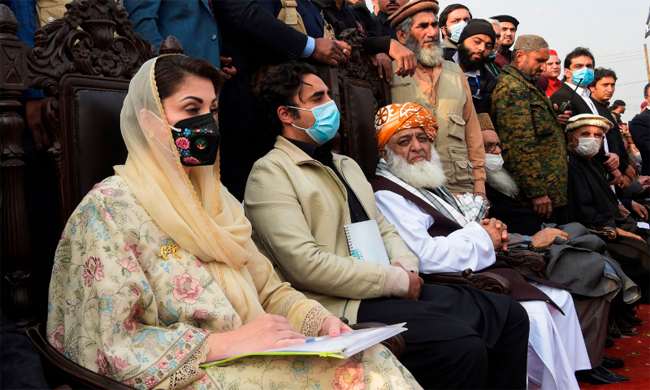Karachi … News Time
Serious flaws in the strategy of the ten-party opposition alliance, the Pakistan Democratic Movement, PDM, led to a situation where the coalition was divided and even a no-confidence vote to remove Prime Minister Imran Khan from power. It felt very weak until the latest proposal of PPP Chairman Bilawal Bhutto Zardari got some backup support which does not exist. They are not even ready for a protest that could only lead to unconstitutional means. Whether one likes it or not, history is with the Prime Minister for two reasons. One is that a no-confidence vote against any prime minister has never been successful. In the past, it failed in 1989, when the then-opposition coalition, despite the Establishment’s support, defeated the IJI. The latest move in 2020 saw a defeat against the chairman of the Senate, despite a majority of the opposition in the Senate. Thus, in Islamabad in March, Bilawal Bhutto Zardari or the PPP’s changed strategy and unannounced opposition to the sit-in clearly indicates that the party is on the defensive and the PDM considers the March plan to be useless. Perhaps the PPP wants the PDM to continue with its plan to hold public meetings and rallies until it is convinced to send the government home. The main flaw in PDM’s strategy is its own statement. If former Prime Minister Nawaz Sharif, who has been in London for the past year, directly attacked the Establishment, the PPP defended a lot and between the JUI-F, Maulana Fazlur Rehman and a few nationalist parties. There is no choice but to hold one public meeting after another. All this confusion has made the PDM movement a non-starter, and now its constituent parties must first work to build consensus among the parties and then come up with a new action plan. Nawaz Sharif’s eloquent speeches not only closed all the doors to any chance of success but also brought the Prime Minister closer to the Establishment.
On the other hand, the PPP does not want to lose either the Sindh government or the Senate elections. Now with the motion of no-confidence, it is even clearer that the PPP, knowing full well, wants friendly opposition to the ruling PTI, which can neither oust the government through a no-confidence vote or protest. The PDM now looks like a soft opposition alliance and its future looks bleak. Therefore, for all practical purposes, the PDM has withdrawn all its action plans in the last three months, claiming a strategy of resigning from Parliament and Provincial Assemblies to remove the Prime Minister from power by December 31. The opposition also abandoned its plan to march to Islamabad and now postponed it till March. The PDM also appeared confused over its decision not to boycott the by-elections and to run in the Senate elections. In a way, they have accepted the current democratic system, which they call selective. She also appeared divided over a nationwide protest strategy, such as a strike or a court arrest. The PDM, which has set a January 30 deadline for the resignation of the prime minister, is now facing an internal crisis for its own survival and when the deadline passes without any future plans. He may face another problem. It will be interesting to see the post-Senate election scenario as the government intends to make drastic changes to the system through legislation once it gains a majority in both houses. The opposition will be tested on how it will run in the local elections expected by May this year. The PDM has not been able to implement any of its action plans in the last three months, which has confused its own structure, position and file and has severely affected public participation in its public meetings.
It now appears that it may have to reconsider its long march plan, which has no choice but to extend its deadline for the resignation of the prime minister. Despite the presence of all mainstream opposition parties, the PDM has never emerged as a strong coalition. It lacks seriousness and determination, which is reflected in the fact that, unlike past alliances, they have barely come out of counter-narratives, strong resolutions on national and international issues, as we have seen in the Movement for the Restoration of Democracy (MRD). The PDM has had differences since its inception, starting with the issue of who should lead the coalition. Although the PML-N had suggested the name of Maulana Fazlur Rehman of the JUI-F, the PPP and the ANP had suggested that the PDM chief should be rotated every month or three. If a direct premature attack on the powerful establishment of former Prime Minister Nawaz Sharif surprised the PPP, the PPP’s defensive and soft opposition gave the impression that it was not in a mode of movement or resistance. As a result, if this alliance is to be maintained now, there is no choice but to adopt a new strategy.
It will also be interesting to see what the former President Asif Ali Zardari will gain in return for the message of reconciliation in the Establishment Knowing that the no-confidence vote without the support of two strong allies of Prime Minister Imran Khan, the PML-Q and the MQM (Pakistan), would clearly indicate PPP Chairman Bilawal Bhutto’s proposal. The PPP is not in the mood to go too far with the PDM and has accepted the current system and the prime minister as long as there is no disagreement between the government and the establishment on policy matters. There is no sign of cracks at the moment and whatever differences of opinion there were, he thanked the now disqualified Prime Minister Nawaz Sharif for taking the position.




